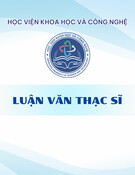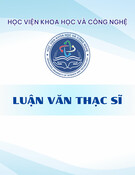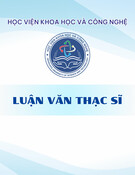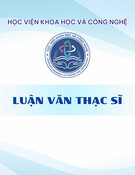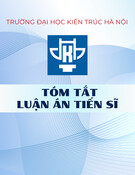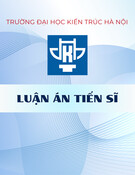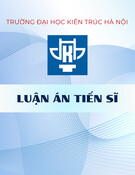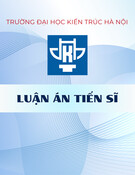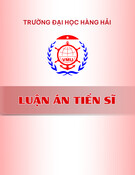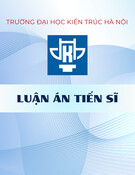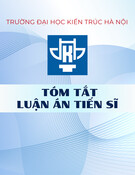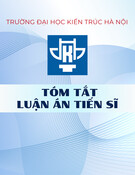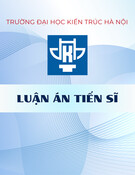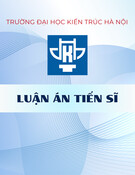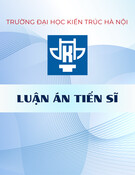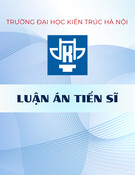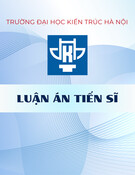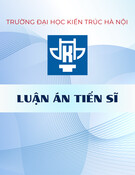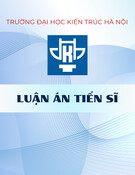MINISTRY OF EDUCATION AND TRAINING MINISTRY OF DEFENSE
MILITARY INSTITUTE OF TRADITIONAL MEDICINE
LUONG THI KY THUY
STUDY ON THE THERAPEUTIC EFFECTIVENESS
OF TG EXTRACT ON CHRONIC SKIN ULCERS
Speciality: Traditional medicine
Code: 62720201
DOCTOR THESIS ABSTRACT
HANOI – 2016
THIS STUDY WAS COMPLETED AT THE MILITARY INSTITUTE OF TRADITIONAL MEDICINE
Science instructors:
Associate Professor, Medicine Doctor LE DINH ROANH
Associate Professor, Medicine Doctor PHAM VIET DU
Reviewer 1: Associate Professor, Medicine Doctor LE LUONG DONG
Reviewer2: Associate Professor, Medicine Doctor LE VAN DOAN
Reviewer3: Medicine Doctor PHAM THI VAN ANH
The thesis is protected by The National Council at The
Military Institute of Traditional Medicine
At (time) date month 2016
YOU CAN READ THIS THESIS IN:
National Library
Library of Central Medicine Information
Military Institute of Traditional Medicine Library
4
INTRODUCTION
1. Reason for choosing this subject
A chronic skin ulcer (CSU) is an injury in the form of a sore on the skin or a mucous membrane. A CSU is defined as a wound lesion that lasts more than four weeks without remarkable healing tendency or as a frequently recurring wound. CSU seriously affects the quality of life of patients and causes immense costs to the healthcare system. Although the prevention and treatment of CSU has improved greatly, CSU still remains a great challenge for modern medicine.
According to traditional medicine theories, CSU has various symptoms such as local sores, chronic pain and itching, it is also prone to relapse. Traditional medicine has been used for the prevention and treatment of CSU for many years and it has now expanded and is used worldwide.
TG extract or chicken egg yolk oil which is mentioned in “Miraculous Effects of Southern Medicine” (Tue Tinh, 14th century) and “Compendium of Medical Material” (Shizhen Li, 15181593), is used to treat ulcers because of its functions: qingre (clearing heat), anti inflammatory, pain relief, moisturizing and proliferation. 2. Objectives of thesis
1) Determine the chemical composition and safety of TG extract. 2) Evaluate the effects of TG extract on CSUs in vitro rabbits. 3) Evaluate the clinical therapeutic efficacy of TG extract on CSUs
stage II and III. 3. Scientific and practical significances
Determine the basic components of TG extract. The results show that TG extract delivers effective treatment of CSUs: increases fibroblast migration, proliferation and activity, boosts the extracellular matrix (ECM) biosynthesis, increases angiogenesis and epithelial proliferation, and decreases MMP9, reduced destruction of the ECM, therefore CSUs heal faster. Give a hypothesis of action mechanism of TG extract in the treatment of CSUs.
5
Provide a simple remedy which is easy to produce and can be
used acrosstheboard in the treatment of CSUs. 4. The structure of the thesis
Our thesis consists of 129 pages: Introduction (3 pages); Background (33 pages); Method (25 pages); Results (37 pages); Discussion (29 pages); Conclusion (1 page); Request (1 page). There are 158 references (Vietnamese: 21, English: 119, Chinese: 18); 29 tables, 1 chart, 68 figures, 14 appendixes in the thesis.
Chapter 1: BACKGROUND
1.1. Skin histology
The most common structural components within the dermis is the extracellular matrix (ECM). Understanding the structure and function of the ECM is the key to successful treatment of CSUs. 1.2. Pathophysiology of acute wound healing
Acute wound repair process can be divided into 4 continuous and overlapping phases: coagulation, inflammation, proliferation and ECM remodeling. 1.3. Pathophysiology of chronic skin ulcers
CSUs do not heal in normal phases and time scales. Despite intensive treatment, the wound is unable to close. The pathological disorders: (1) Proliferation reduction; (2) Imbalance between enzymes for protein hydrolysis and inhibitors; (3) The appearance of old and weak cells. 1.3.5. Treatment for chronic skin ulcers
Systemic therapy (according to etiology) Topical treatment: debridement, antiinflammatory, antiinfection, maintaining moisture balance, biological agents, skin grafts and other forms of treatment. However, CSUs which are still a challenge for modern medicine, still don’t have a specific drug to treat them. 1.4. Traditional medicinal opinion on chronic skin ulcers Traditional medicine considers that CSU belongs to the “ulcer” branch of the Ulcer and Sores diseases.
6
In traditional medicine, the pathogenesis of CSU is theoretically caused by “Re (heat)”. The pathogenic process of CSU was described first in “Lingshu: yongju” as follows: “harmful cold accumulates in the meridian and the results in a stiffness in blood flow and obstruction, which inhibits the circulation of defensive energy, leading to inflammation. Subsequently, harmful cold changes into harmful heat, which causes tissue damage and then pus formation.”
The pathologic mechanisms underlying the refractory skin ulcers are that “long term disease results in a deficiency and stasis in both qi and blood, leading to a disorder of ying (nutrition) and wei (immunity) and skin dystrophy.” The “Xu (deficiency)” and “Yu (stasis)” are two major pathologic factors of the development of CSUs.
Y. J. Wang and H. F. Que (2009) divided CSU into three syndrome types of blood stagnation with dampnessheat, qi deficiency with blood stasis and spleen deficiency with dampness encumbrance.
Treatment of a CSU follow the principle of “QingHuaBu” method to treat for the syndrome differentiation: 1) Qingre (clearing heat), zhishi (remove dampness), huayu (resolve stasis), shengji (stimulate the growth of new skin) to treat dampnessheat syndrome; 2)Tonify qi, huayu, shengji to treat qi deficiency with blood stasis syndrome; 3) Jianpi (strengthen spleen), zhishi, shengjitotreatspleen deficiency with dampness encumbrance syndrome; and the last target is “qufushengji, jipingshengzhang” (removing necrotic tissues to stimulate the growth of new skin). 1.5. Experimental chronic skin ulcer models
Rudolph R. (1979) introduced an animal model of Adriamycin ulceration. More than 50 days (rats) and 4565 days (rabbits) of prolonged testing is suitable for experimental research. 1.6. TG extract
TG extract or chicken egg yolk oil mentioned in “Miraculous effects of Vietnamese medicine – Ten therapies” (Tue Tinh, 14 th century), can be used for treating ulcers, sores and burns. Chicken egg yolk oil is made by a traditional heating method and has a sweet, sour,
7
warm, nontoxic characteristic. This remedy is useful for treating venereal diseases, ulcers and burns.
Rastegar F. et al (2011) studied the effect of egg yolk oil in the healing of 3rd degree burn wounds in rats which showed that burn wounds healed faster and had abundant reepithelialization without scarring.
Chapter 2: SUBJECTS AND METHODS
2.1. Drugs and Chemistries
TG extract which was made in the Pharmacy Department of The Military Institute of Traditional Medicine is a topical concentration of 6 grams of medicine per milliliter (Figure 2.1). 2.2. Subjects
Determine the chemical composition of TG extract: 6 samples were
taken at random from a batch of new products. Determine the safety of TG extract. Skin irritation: 03 New Zealand White rabbits. Acute toxicity of subcutaneous and oral administrations: Swiss white mice (National Institute of Hygiene and Epidemiology), at least 10 mice per batch.
Dermal acute toxicity: 36 New Zealand White rabbits.
Figure 2.1. TG extract packaged form
Dermal subchronic toxicity: 30 New Zealand White rabbits. Experimental therapeutic effects: 30 New Zealand White rabbits. Evaluate clinical therapeutic effects: 64 chronic skin ulcers stage II and III of 59 inpatients and outpatients at Departments of Military
8
Central Hospital 108 (A1, A2, A6, A7, A10, A15, B1A, B1B, B1C) from 10/2012 to 04/2015.
Included criteria: stage II and III chronic skin ulcers. Excluded criteria: stage IV skin ulcers, syphilis sores, tuberculosis, leprosy; patients with systemic immunosuppression, systemic disease, mental illness, blood disease, lifethreatening, patients not cooperating or dropped out of the treatment.
9
2.3. Method 2.3.1. The chemical composition analysis and the safety of TG extract 2.3.1.1. Chemical composition analysis
Determine fatty acids in Gas Chromatography Mass Spectrometry (GC/MS). Quantitate some metals in Atomic Absorption Spectroscopy (ASS). Determine pH in Seven Easy device. 2.3.1.2. Determine the safety of TG extract
* Evaluate acute toxicity: oral, subcutaneous (WHO guidelines) and topical administration (the guidance of the Organization for Economic Cooperation and Development (OECD).
* Evaluate chronic toxicity: topical administration on rabbit for 90
days (the guidance of the OECD number 411, 1981). 2.3.2. The therapeutic efficacy of TG extract on experimental chronic skin ulcers
Method: Controlled experimental study on animals. Use the model of Rudolph R et al: Experimental skin ulcers
produced by Adriamycin on rabbits.
Experimental treatment model of TG extract Each rabbit was treated with 2 parallel therapies: Controlled ulcers: Group 1 (10 rabbits): Change the dressing, wash and cover sores with gauze soaked in NaCl 0.9% solution. Group 2 (20 rabbits): Silver Sulfadiazine grease (SS). The study ulcers (30 rabbits): topical TG extract. Change the dressing once every 2 days and photograph the ulcers.
Location: Laboratory National Institute of Burns.
10
Figure 2.5. Measure the size of CSUs using the Image Pro Plus software
Evaluate the therapeutic efficacy in general anatomy Measuring size: perform on ulcer photographs (with standard ruler (cm): Askina, B. Braun) on the 1st day, 14th day and 22nd day of treatment using polygon mode of the Image Pro Plus 4.5 software (America) (Figure 2.6). Evaluate the effectiveness of TG extract by rate of ulcer size reduction: Percentage change in wound area of a CSU (%) = (initial size – inspection time size)/initial size x 100 Evaluate the effectiveness of experimental treatment on scoring system by Sanada DESIGN H et al (2004) (Table 2.2.).
Histopathology Biopsy the ulcers 3 times: 1st day, 14th day, 22nd day of the treatment. Histopathological test: H&E (hematoxylin eosin) staining, scanned by light microscope.
Immunohistochemistry: Randomly selected biopsy samples of 5 animals, immunohistochemical staining (ABC method) to represent CD34, Vimentin and MMP9.
Ultrastructure: Template biopsies were scanned on electron microscope (JSM 5410LV, JEOL, Japan), and transmission electron microscope (JEM 1400, JEOL, Japan). 2.3.3. Evaluate clinical therapeutic effectiveness of TG extract Method: clinical trial, longitudinal and crosssectional study. Systemic therapy: follow to protocol.
11
Site treatment: prepare ulcers bed: clean the surface, excision. All lesions had their dressing changed, cleansed and ointment was applied once per day.
Medication: Apply TG extract on ulcer surface once per day. Dosage: 0.5 to 1 ml of TG extract per 1000 mm2 of skin. Cover and hold a thin piece of gauze in place.
Method of evaluating the clinical therapeutic effectiveness Measuring ulcer size: Measure the size of ulcers on photographs taken at the moments: the start, the middle and the end of treatment using polygon mode of Image Pro Plus 4.5 software (US).
Evaluate the ulcer size changing: Percent of ulcer size reduction (%) = (initial size – inspection time
size)/initial size x 100
Table 2.2. Ulcers scoring based on the DESIGN criteria
DESIGN criteria
Values
Score
Depth Exudate
Size (mm2)
Infection
Granulation tissue
Necrotic tissue Pocketing
I, II, III, IV stage No; Less to medium; Much 0; <400; 400 to<1600; 1600 to < 3600; 3600 to < 6400; 6400 to< 10000; ≥ 10000 No; obvious symptoms or localized infection Unknown (closed wounds) ≥50% area of injury < 50% area of injury No; Yes No; Yes
0; 3; 6 0; 3; 6; 8; 9; 12; 15 0; 3 0 3 6 0; 3 0; 6
Evaluate the clinical effectiveness of treatment based on DESIGN
scoring system of Sanada H et al (2004) (Table 2.2).
Use the following formula to determine the change of detail scores: Changing in detail scores according to DESIGN: Changing in detail score of ulcers = (inspection time score)
(initial score)
Proportion of effective treatment for ulcers
12
Efficiency ratio (%) = (Number of effective ulcers) / (number of
effective ulcers + number of inefficient ulcers) x100
Effective: reducing ≥50% of total score compared to the initial score. Ineffective: reducing<50% of the total score compared to the initial score. Percentage of complete healing (%) = (number of < 1 cm2ulcers at
the end of the treatment) * 100 / total number of ulcers.
2.4. Statistical Analysis.
Use Epi Info 2008 and SPSS 13.0 software and statistical analysis
methods in medical research and evaluate the results.
13
Chapter 3: RESULT
3.1. The chemical composition and the safety of TG extract 3.1.1. The chemical composition of TG extract: shown in Table 3.1.
Table 3.1. Fatty acid composition of TG extract
No. 1 2 3 4 5 6 7 8 Composition Palmitic acid (C16:0) Palmitoleate (C16:1) Stearic acid (C18:0) Oleic acid (C18:1) Linolenic acid (18:2) Arachidonic acid (C20:4) Docosahexaenoic acid (C22:6) Cholesterol n 6 6 6 6 6 6 6 6 Content (mg/ml) (± SD) 21,01±0,63 1,72±0,16 15,27±1,55 38,13±3,20 6,79±0,64 1,14±0,09 1,77±0,30 21,01±0,63
linolenic acid (omega3,
Essential components of TG extract are the longchain fatty acids: oleic acid (omega9), omega6), docosahexaenoic acid (DHA), arachidonic acid (a type of omega6) and cholesterol. Magnesium (Mg) (3,28±0,63), zinc (Zn) (3,95±1,93) are presented in TG extract. pH of TG extract was 5.2 ± 0.2, acidic. 3.1.2. The safety of TG extract
Determine the acute toxicity of TG extract Identify the acute toxicity of subcutainous administration: With volume, the highest concentration of TG extract 60g medicine per kg in rats, there were no signs of acute toxicity. LD50 of subcutainous TG extract was unidentified.
Determine acute toxicity of oral administration: maximum dose of 450 mg per kg in rats did not show signs of acute toxicity, after a week of tracking. LD50 of oral TG extract was unidentified based on the Litchfield – Wilcoxon method.
14
Identify the acute toxicity of topical administration: The lethal dose 50% of the animals (LD50) of TG extract with the highest dose (14,4g per kg) was not able to be determined.
15
The subchronic toxicity of TG extract After 6 weeks and 12 weeks of topical TG extract, no special expression was figured out in the control group and two study groups. The hematopoietic function, liver and kidney functions tests in both 2 study groups have no significant difference compared to the control group and before treatment (p > 0.05). Liver, kidney and skin histopathology did not show any pathological lesions. TG extract had no experimental subchronic toxicity. 3.2. Therapeutic efficacy of TG extract on experimental chronic skin ulcers 3.2.1. Experimental chronic skin ulcers in rabbits
2 skin ulcers were produced successfully on each of 30 rabbits with similar sizes and characteristics. Average time to produce ulcer was 21.3 ± 2.6 days, average size was 11.1 ± 3.5 cm2. 3.3.2. The therapeutic effectiveness of TG extract
Treatment duration: Table 3.13. Compare treatment duration between groups (day(s))
Group NaCl 0,9%(1) SS (2) TG extract (3) n 10 20 30 ± SD 29.9±2.4 26.7±2.0 22.3±2.9 p p12<0,01 p23<0,001 p13<0,001
Healing time of the treatment group was significantly shorter than the 2 control groups (p <0.001), (ttest). Changes in ulcer size:
Table 3.14. Changes in ulcer size after 14 and 22 days of treatment
Group
Time After 14 days of treatment After 22 days of treatment TG extract (1) NaCl (2) SS (3) TG extract (1) NaCl (2) SS (3) n 30 10 20 30 10 20 ± SD 2.99±1.31 5.48±2.11 4.95±1.57 0.52±0.55 3.44±1.31 2.15±0.67 p p12<0.05 p13<0.05 p23>0.05 p12<0.01 p13<0.01 p23<0.05
16
The ulcer size of TG extract group decreased faster than the 2 control groups did (p <0.01). The proportion of complete healing is calculated by the ratio of ulcer which completely closed or size <1cm2 on the 22nd day.
Table 3.15. Compare effectiveness of completely closed ulcer on the 22nd day Group Effectiveness Ineffectiveness Total
p p12<0.001; p13<0.001; p23<0.05 TG extract (1) NaCl 0,9%(2) SS (3) Total 29 (96.7%) 1 (10%) 11 (55%) 41 1 (3.3%) 9 (90%) 9 (45%) 19 30 10 20 60
TG extract group had healing rates significantly higher than control groups (p <0.001) (Fisher test).
Evaluate ulcers according to DESIGN system Table 3.16. Compare DESIGN total score between the groups
DESIGN p Group
NaCl 0,9% (n=10) pn0n22<0.05 14th day 16.8±2.9
SS (n=20) pn0n22<0.05 16.5±3.2
TG extract (n=30) pn0n14,n22<0.01 total score 0 day 21.01 21.3±0.72 21.2±0.63 6.3±0.9 22nd day 11.1±3.51 12.5±3.12 0.9±1.63
p p123>0.05 p12,3<0.01 p12,3<0.01
After 14 and 22 days of treatment, total score of TG extract group decreased significantly faster compared to two control groups (p <0.01) (ttest). The therapeutic efficacy according to the rate >50% of reduction
on the DESIGN total score Table 3.17. Compare therapeutic efficacy between the groups according to DESIGN p Group Effectiveness Total
p13<0.05 TG extract (1) 29 (96.7%) Ineffectivenes s 1 (3.3%) 30
17
p12<0.001 NaCl 0,9%(2) 4 (40%) 6 (60%) 10
p23>0.05 SS (3) 15 (75%) 5 (25%) 20
Total 45 15 60
The effective treatment proportion of TG extract group was significantly
higher compared to control groups (p <0.05, p <0.001) (Fisher test).
Histopathology The similar ulcers were made in rabbits: frozen necrotic tissue,
inflammatory cell infiltration (Figure 3.6).
a
b Figure 3.6 and 3.10. Histopathology of skin ulcers which were treated with TG extract. a 3.6. Initial treatment, frozen necrotic tissue (**), inflammatory cells ((cid:0) ). b – 3.10. TG extract group on the 14th day of treatment: Fibroblasts proliferation ((cid:0) ), angiogenesis ((cid:0) ), epithelial cells (**) .
The control groups still showed remarkable inflammatory process after 14 days of treatment. There was moderate proliferation of fibroblast and blood vessel after 22 days.
In the TG extract group, there were dominant fibroblast proliferation, angiogenesis, some samples showed epithelial cells on the 14th day (Figure 3.10). Extracellular matrix structure similar to normal skin, a thin epidermis covered after 22 days of treatment: Immunohistochemistry staining CD34 staining
18
Figure 3.14.CD34 staining of skin samples which was treated with TG extract at 14th day. Positive blood vessels with dark brown CD34 (Rabbit 22). X400 (cited).
The positive level with CD34 of the groups was different over time. It was slightly positive with CD34 of control groups on the 14th day, strongly positive on the 22nd day. The TG extract group had a strong positive with CD34 on the 14th day and decreased after 22 days of treatment. Vimentin antibody staining
Figure 3.15. Vimentin antibody staining, TG extract group, 14th day, X400
At the beginning, all skin ulcer samples were negative with Vimentin. On the 14th day, the control groups samples had light positive with Vimentin, increased on the 22nd day. The TG extract group samples had strong positive with Vimentin on the 14th day and had decreased on the 22nd day. MMP9 antibody staining
19
Figure 3.16. 0.9% NaCl control group on the 14th day, strong positive with antibodies MMP9. X400.
At the beginning, all ulcers were strongly positive with MMP9. After 14 days, the control groups ulcer had strong positive with MMP9 and reduced on the 22nd day. The TG extract group had strong positive with MMP9 on the 14th day and only scattered on the 22nd day. Ultrastructure
Ultrastructural characteristics of chronic skin ulcers before treatment: infiltration of inflammatory cells, decreasing of the extracellular matrix density, disruption, swelling and disintegration of collagen fiber bundles, degeneration of fibroblasts.
Figure 3.18. Extracellular matrix before treatment: disruption, swelling and disintegration of collagen fiber bundles ((cid:0) ). TEMx10000. Ultrastructural characteristics of 2 control groups: After 14 days of treatment, the inflammation was still dominant. SS greased group appeared migratory fibroblasts, increased collagen synthesis activity. After 22 days of treatment, there is increased migration and activity of fibroblasts in both groups but stronger in SS group.
20
A
B Figure 3.30. Ultrastructure of 0.9% NaCl group ulcers (A): fibroblasts (**), extracellular collagen ((cid:0) ) TEM x20000. SS group (B, 3.33) at 22nd day. Bfibroblasts, micro collagen (**), granular endoplasmic reticulum (*). TEM x25000
A
B Figure 3.25 and 3.26. Ultrastructure of TG extract group ulcer on the 14th day. A, new extracellular collagen ((cid:0) ). X15000 TEM. B, fibroblasts, granular endoplasmic reticulum (**), microfilaments near cell membrane ((cid:0) ). TEM X2500.
A
B Figure 3.34 and 3.36. Ultrastructure of ulcers which were treated with TG extract, 22nd day. A, epithelial (**). SEM X2000. B New collagens (**). TEM x10000
21
On the 14th day, the TG extract group showed the proliferation and migration of active fibroblast, strong biosynthesis and secretion of collagen. New extracellular collagens, strong angiogenesis.
On the 22nd day of the TG extract group, epithelial cells covered the surface of ulcers. Collagen structured and arranged similarly to normal dermis. Most of fibroblast reduced activity. 3.3. Evaluate the clinical therapeutic efficacy of TG extract for chronic skin ulcers 3.3.1. Characteristics of patients and ulcers
There were 59 patients with stroke, nerve damage, cancer metastases, depletion accounting for 59.32% (35). The injury patients accounted for 27.12% (16) and 8.47% of patients due to complications of treatment, 5.08% diabetes. 5 (8.5%) patients had 2 ulcers, 54 (91.5%) patients had one ulcer.
Table 3.19. Site and rate of skin ulcers were treated with TG extract
Diagnosis Number Ratio
Leg ulcers 7 10.9%
Forearm and hand ulcers 4 6.3%
1 1,6%
29 45.3%
Arm ulcers Buttock ulcers (tailbone, ischium, trochanter) Thigh ulcers 3 4.7%
Knee ulcers 4 6.3%
Heel ulcers (heel, ankle) 13 20.3%
Instep ulcers 3 4.7%
64 100.0% Total
Tailbone, ischial, trochanteric ulcers accounted for 45.3%. The heel
ulcers accounted for 20.3% and leg ulcers were 10.9%.
Table 3.20. Ulcer classification before treatment (NPUAP / EPUAP)
Before treatment Number Ratio classification
22
9 14.1% Stage II
55 85.9% Stage III
64 100.0% Total
Stage III ulcers are the majority with 55/64 (85.9%).
3.3.2. Clinical effectiveness of TG extract on chronic skin ulcers
Duration of treatment: Average duration of treatment was 25.67 ±
14.34 day, the shortest: 7 days, the longest: 68 days.
Changing in ulcer size
Table 3.23. Compare ulcer size (mm2) before and after treatment and the rate of complete healing (test t)
Area (mm2)
p
n
Complete healing
Before treatment1 ( ± SD)
End of treatment2 ( ± SD)
p12<0.01
<400
264.1 ±70.8
23.2 ± 18.2
7 (100%)
7
p12<0.01
400<1600
36
797.5 ± 298.2
99.7 ± 95.7
34 (94.4%)
p12<0.01
1600<3600
15
2399.6 ± 544.2
683.0 ± 574.5
8 (53.3%)
p12<0.01
3600<6400
4374.4 ± 255.1
1115.0 ± 1057.3
1 (33.3%)
3
p12<0.01
6400<10000
7375.1 ± 597.2
2046.8 ± 2681.3
2
>10000
19029.5
318.6
1
Total
64
50 (78.1%)
Ulcer size from 400 to <1600 mm2 are the most common, followed by ulcers size 1600 to <3600 mm2 and <400 mm2. The ulcer size
23
reduced significantly after treatment (p<0.01). The average rate of complete healing is 78.1%. Ulcer size <400 mm2 has the highest rate with 100%. The rate of ulcer size from 400 to <1600 mm 2 is 94.4%. Other larger ulcers have lower complete healing rates.
Effective treatment: Effective if ulcer size reduced ≥ 50%, ineffective if ulcer size
reduced<50% compared to before treatment.
Table 3.24. Effectiveness of treatment according to the area of the ulcer
Ulcer size Number Ratio
6 9,4% Reduced<50%
58 90,6% Reduced ≥ 50% or closed
64 100,0% Total
There was 90.6% (58/64) ulcers with ulcer size reduction ≥ 50% or completely closed, only 9.4% (6/64) ulcers with ulcer size reduced<50%.
Results of treatment according to DESIGN
ờ
Table 3.25. The results of clinical treatment according to DESIGN p
Th i gian
n
Criteria
Middle
64 64 64 64 64 64
Exudation Size Infection Granulation Necrosis Pocketing
2.68±1.20 4.48±1.99 0.83±1.35 3.23±0.96 0.69±1.27 1.29±2.49
End of treatment2 0.78±1.33 2.15±2.53 0.23±0.81 1.34±1.59 0.32±0.94 0.09±0.74
p12<0.01 p12<0.01 p12<0.01 p12<0.01 p12<0.01 p12<0.01
64
Total
13.20±6.79 4.92± 6.252
Before treatment1 5.12±1.38 6.48±1.97 2.91±0.52 5.86±0.63 2.72±0.88 3.05±3.02 26.14± 5.881
p
p12<0.01
24
The results showed that: all the details and total scores before and
at the end of treatment were statistical significant differences (p <0.01).
25
Table 3.26. Therapeutic efficiency of TG extract according to DESIGN
DESIGN Number Ratio
DESIGN total reduced <50% 7 10.9%
DESIGN total reduced ≥50% 57 89.1%
64 100.0% Total
Treatment for chronic ulcers with TG extract showed that there were 57/64 ulcers (89.1%) decreased in total score ≥50% DESIGN, 7/64 ulcers (10.9%) decreased in total score DESIGN <50% compared to before treatment.
Figure 3.40.The ulcer of patient Luong Van G, prior to treatment with TG extract. Figure 3.42. At the end of treatment with TG extract (52nd day). Comment: In general, the ulcers which were treated with TG extract not only closed completely but also had characteristics such as a soft skin, no scars, most of them had structures, morphology similar to normal skin. In some cases, the surface is covered incompletely with a thin layer of skin epithelium (Figure 3.42).
Chapter 4: DISCUSSION
4.1. The components and the safety of TG extract 4.1.1. The chemical components of TG extract
TG extract contains saturated and unsaturated fatty acids of omega 3, omega6, omega7 and omega9 groups which are particularly interesting in modern medicine due to their biological activities . Oleic
26
acid (omega9): as an antioxidant can prevent the effects of free radicals. Linolenic acid has antioxidant effects, especially used in the treatment for eczema. Arachidonic acid (AA) (a type of omega6) is the most common eicosanoid precursor, is metabolized in the cell to form prostaglandins, leukotrienes that are essential signaling molecules. They control for multiple systems of the body, such as inflammation and immunity and also is a component of cell membrane phospholipids, participate in the repair process and proliferation of cells. Docosahexaenoic acid (DHA) promotes the immune response, the chemical elements of cellular response, treating for autoimmune diseases.
In addition, TG extract contains cholesterol which is not favorable environment for the growth of bacteria. Magnesium and Zinc participate in components of proteolytic enzymes depending on metals, helps balance in ulcers. 4.1.2. Evaluate the safety of TG extract
Determine the acute toxicity of TG extract Under the guidance of the Organization for Economic Cooperation and Development (OECD), TG extract can be applied directly to the skin lesions so it should be tested oral acute, subcutaneous (usage likely) and topical administration toxicity.
With all three acute toxicity tests, there were unidentified the lethal dose 50% of the experimental animals (LD50) of TG extract. Thus, TG extract has no acute oral, subcutaneous and topical toxicity. Determine the subchronic toxicity of TG extract Based on the guidance of the OECD (1981), we evaluated the sub chronic toxicity of TG extract in 90 days on rabbit skin. The study results showed that TG extract applied on skin continuously for 12 weeks at the highest dose (14,4g / kg / day) did not cause negative impact on general condition such as movement, liver, kidney and hematopoietic functions compared to the control groups and before treatment (p> 0.05). The histopathological images of the liver, kidney,
27
skin also showed no signs of macroscopic and microscopic disease or injury compared to control samples.
Thus, TG extract did not cause subchronic toxicity on usage dose used in clinical practice (4,8g / kg / day) and triple dose (14,4g / kg / day) in 90day trial based on the guidance of the OECD (1981). 4.2. Experimental therapeutic efficacy of TG extract on chronic skin ulcers 4.2.1. Set up chronic skin ulcer model on rabbits
The ulcers on rabbits were created by the way of Rudolph R et al (1979) and the macroscopy, histopathology, immunohistochemistry and ultrastructure of injury were consistent with the pathological disorders of CSUs. The total duration of the ulcers is 50 to 60 days. Thus, we succeeded in creating CSUs on rabbits for research purposes. 4.2.2. Evaluate the effectiveness of treatment
The duration of treatment Time to completely close a chronic wound is considered at the end of the treatment and are defined as complete reepithelialization of skin and not require drainage or dressing, is identified be 2 times of dressing changes for about 2 weeks.
The Table 3.13 shows that the ulcers on experimental animals were healed with an average time 29.9 ± 2.4 days. Two granted mechanisms are shrinkage and tissue regeneration. The SS group average time shorter healing statistical significance compared to 0.9% NaCl group (p <0.01). Recognized mechanism of SS is because silver's antibacterial properties. Average time instant completely wound of the treatment group was 22.3 ± 2.9 days shorter with statistical significance (p <0.001) compared to selfhealing time of about 1 week and faster statistical significance compared to patients treated with SS. This result allows us to think that the therapeutic efficacy of TG extract is due to address the site pathological disorders the main cause of CSUs.
The ulcer size Ulcer size and its changes during the treatment are important criteria. In our study, the healing time of ulcers which were treated with
28
TG extract is 22.3 ± 2.9 days. Therefore, based on the facts and the "Guidance for Industry: Chronic cutaneous ulcer and burn wounds Developing products for treatment" of the US Food and Drug Administration, we determine the final time of treatment is 22th day.
The results showed that ulcers which were treated with TG extract miniaturized faster statistically (p <0.01 and p <0.05) compared to the control groups. At 22th day, there were 29 lesions (96.7%), with an area of < 1cm2 and only 1 case (3.3%) with an area > 1 cm2. Meanwhile, the average size of the control ulcers still is 3.44 ± 1.31cm2(NaCl group) and 2.15 ± 0.67 cm2(SS group), only 11 cases had area < 1cm2 (55%). Kotz P. et al evaluated the therapeutic effect of ice containing silver (2009), this percentage was 27% in 21 days of the average duration of treatment. Our results also showed lower efficiency in SS group than TG extract.
Evaluate the effectiveness of treatment according to DESIGN scale DESIGN scale which was launched by Sanada H et al in 2004 is considered as a tool to evaluate therapeutic effect of products treating CSU in clinical trials (Japanese Society of Pressure). The criteria shows all the characteristics of CSU and is divided into detailed scale helping quantify the changes in clinical practice (Table 2.2).
The results showed that TG extract reduced detailed scores faster on compared to the control groups (p <0.01). On 22nd day, 29/30 (96.7%) lesions which were treated with TG extract reduced the total score ≥ 50% compared to before treatment. This rate is 40% in NaCl 0.9% group and 75% in the SS group. Thus, TG extract reduced ulcer size, increased granulation tissue, decreased necrosis and reduced the DESIGN total score faster with statistical significance compared to the control groups (p < 0.01). 4.2.3. Activity mechanism of TG extract
In chronic skin ulcers, factors such as foreign bodies, necrotic tissue, bacteria (biofilm membrane), and the free radicals prevent the healing process. The authors around the world are focusing on: increasing the level of growth factors; maintaining the balance between proteolytic enzymes and their inhibitors; stimulates proliferation and increase fibroblast activity. Trials evaluating the effectiveness of
29
traditional medical treatment of chronic skin ulcers are also based on the same grounds. The results of histopathology, ultrastructural and immunohistochemistry made, we believe that TG extract had the following activity mechanisms: Stimulate angiogenesis, increased migration, proliferation and fibroblast activity
to normal skin.
The histopathological, immunohistochemical and ultrastructural results showed a prolonged inflammatory process, slow proliferation of CSU in the control groups. By contrast, the ulcers which were treated with TG extract showed dense appearance of fibroblasts, blood vessels, strong proliferation of epidermal cells covering ulcer surface. On 22nd day, the ulcers which were treated with TG extract showed histological Ultrastructure and structure similar immunohistochemistry (CD34 and vimentin) showed the repair process of extracellular matrix: collagen bundles were arranged in codirection, reduced fibroblast collagen biosynthesis, reduced the number of vessels, reduced levels of both positive for antibodies.
About pathogenesis, this process depends on the presence of fibroblast proliferative factors, increased trans factors, endothelial proliferation and epidermal proliferative factor (EGF). Thus, TG extract increased these factors and thereby accelerating the healing process. In particular, a major role for the proliferation of granulation tissue is due to arachidonic acid (AA) and docosahexaenoic acid (DHA) which were presented in TG extract. Arachidonic acid plays a role for many systems of the body, mainly in inflammation and immunity, participating membrane structure. Docosahexaenoic acid stimulated immune response and controlled the secretion of cell chemical elements.
In the reconstruction period, local proliferation of extracellular matrix decreased, only a small number of activated fibroblasts involved in the process of repairing the extracellular matrix, blood vessels were reconstructed similar to normal skin. The results showed that in epithelial were completely renewable, no scar tissue formation, consistent with research by Rastegar F. et al (2011). Thus, TG extract also regulated the increased collagen synthesis in granulation tissue,
30
thereby improving the quality of wound healing, preventing scar formation.
The effect of reducing tissue damage At the beginning, all three groups were strongly positive for antibodies MMP9, showed the level extracellular matrix destruction going strong. The level of antibody positive for MMP9 plummeted in the ulcers which were treated with TG extract on the 14 th day showed reduced process of protein destroying. With components mainly fatty acids and high cholesterol showed TG was favorable environment for the growth of bacteria. Besides, the magnesium and zinc ion affected the activation of proteolytic enzymes. TG extract had fatty acids such as oleic acid, linolenic acid which is the antioxidant that may prevent free radicals, reduce toxicity, reduce the destruction of tissue, and prevent one of pathological disorder causes in CSU. The activity mechanism of TG extract can be generalized in the following diagram:
Figure 4.1. Diagram about mechanism of action of TG extract 4.3. Clinical effectiveness of TG extract for chronic skin ulcers
31
Characteristics of patients and ulcers which were treated with TG
extract
According to foreign authors, pressure ulcers are most common in patients who have spinal cord injuries and the elderly. About 95% of pressure ulcers appeared at lower part of the body.
In our study, patients with severe systemic diseases, who must stay in bed, accounted for 59.32%, the highest percentage was sacrococcygeal ulcers, seat area, and line transfer (45.3 %), 2.3% is lowland such as heels, ankles. This result is consistent with the characteristic appearance of pressure CSU.
Evaluate the effectiveness of treatment through duration and the
size of ulcers
The pressure ulcers are extremely difficult healing. The obvious study evaluated for skin ulcer complete healing at a low proportion (10%). Approximately 13% of pressure ulcers complete healing after 2 weeks of intensive treatment. 59% of pressure ulcer stage III may be healed after 6 months of treatment. Nguyen Tien Dung et al (2014) suggested that treatment duration0.1% berberine cream to for CSU was 29.2 ± 12.5 days.
The results of our study showed that the average treatment duration of TG extract for CSU stage II and III was 25.67 ± 14.34 days. Although 85.9% of ulcers is CSU stage III but obviously time of TG treatment was shorter than other methods in hospitals. With average treatment time of TG extract, there were 58/64 (90.6%) ulcers which reduced ≥ 50% in size or complete healing. The average rate of complete healing is 78.1%. Ulcer size <400 mm2 has the highest rate with 100%. The rate of ulcer size from 400 to <1600 mm 2 is 94.4%. Other larger ulcers have lower complete healing rates. Thus, size reduction and closure ratio of TG extract were higher compared to the other authors’ therapies.
Thus, TG extract had effectiveness of clinical treatment for CSU stage II and III, the average treatment duration was 25.67 ± 14.34 days. Treatment of CSUs with TG extract showed that size reduction ratio
32
was 90.6% and the rate of complete closure was 78.1% clinically. Ulcer size <400 mm2 has the highest rate with 100%. The rate of ulcer size from 400 to <1600 mm2 is 94.4%.
Evaluate the effectiveness of treatment according to DESIGN scale Single characteristics cannot be used for ulcer healing assessment. With DESIGN, the sores are fully evaluated clinical characteristics and indicated the real effectiveness of the drug on the individual symptoms. The results of our study showed that TG extract could reduce the discharge, stimulate the proliferation of granulation tissue. Treatment with TG extract reduced DESIGN total score ≥50% in 57/64 ulcers (89.1%). Corresponding to traditional medicine, TG extract can be stasis removing and muscle regenerating.
Clinically, the treatment of TG extract for CSUs helps reducing ulcer size, proliferation of granulation tissue and reducing necrosis. Reduction rate ≥50% of the DESIGN total score achieved 89.1%.
CONCLUSION
The research results allow us to draw the following conclusions: 1. TG extract contains polyunsaturated fatty acids: arachidonic acid, docosahexaenoic acid, oleic acid, linolenic acid and cholesterol. TG extract did not irritate skin. There was no acute toxicity by oral, subcutaneous and topical using.
Topical TG extract did not make chronic toxicity in the equivalent dose used in clinical practice (4,8g / kg / day) and triple dose (14,4g / kg / day) in 90 days under the guidance of the OECD (1981).
2. TG extract had effectiveness of treatment for CSUs in experimental animals: Average time to heal entirely is 22.3 ± 2.9 days; Reducing the size of ulcers faster (p <0.01; p <0.05), the rate of complete closure higher (p <0.01) compared to the control groups.
The detailed criteria (size of granulation tissue, necrosis, exudation) and the DESIGN total score of ulcers which were treated with TG extract reduced faster statistically significant compared to the control groups (p <0.01 ). Histopathological, ultrastructural and immunohistochemical characteristics of experimental CSUs showed that TG extract stimulated
33
proliferation, migration and activation of fibroblasts, increased extracellular matrix synthesis, angiogenesis and reepithelialization, decreased activity of MMP9, reduced extracellular matrix destruction so accelerated healing of CSUs.
3. Clinically, TG extract has effective treatment for chronic skin ulcers stage II, III. The average treatment duration is 25.67±14.34 days. The rate of the reduced DESIGN total score (≥ 50%) is 89.1%. The ulcer size reduction ratio is 90.6%. The percentage of complete healing for all ulcer sizes is 78.1%. The percentage of complete healing of ulcer size <400 mm2 and between 400mm2 to <1600mm2 is 100% and 94.4% respectively.
REQUEST
1. Continue to study the therapeutic effect of TG extract for chronic skin ulcers which are caused by diabetes, venous disease, irradiation and burn.
2. Use more modern research techniques to further elucidate the mechanism of action of TG extract and the applicability in the treatment for chronic wounds.
CATEGORY OF PUBLISHED STUDIES LINKED
TO THE THESIS
ươ ị ỳ ủ ạ ế ự ị 1. L ng Th K Th y, Ph m Vi ế ễ t D , Nguy n Th Tuy t
ủ ứ ộ ậ Nga, (2014), Nghiên c u tính an toàn c a cao TG trên đ ng v t
ự ệ ạ ượ ọ ổ T p chí Y d ề c h c c truy n Quân s , th c nghi m. ự 4(3); 48
56.
ươ ị ỳ ủ ạ ế ự 2. L ng Th K Th y, Lê Đình Roanh, Ph m Vi t D , Đinh
ạ ụ ề Đánh giá tác d ng đi u tr ị Văn Hân, Ph m Lê Bách, (2014),
ự ủ ệ ạ ạ T p chí loét da m n tính c a cao TG trên mô hình th c nghi m.
ượ ọ ổ Y d ề c h c c truy n Quân s , ự 4(2), 1522.
ươ ị ỳ ủ ắ ạ 3. L ng Th K Th y, Ph m Xuân Th ng, Lê Đình Roanh
ứ ể ấ ặ (2015), Nghiên c u đ c đi m hình thái siêu c u trúc quá trình
ự ề ế ệ ạ ậ ộ ượ li n v t loét da m n tính trên đ ng v t th c nghi m đ ề c đi u
ị ằ ạ ọ ệ T p chí y h c Vi t Nam. tr b ng cao TG, 437; 139138.
ươ ị ỳ ủ ạ ị ế ự 4. L ng Th K Th y, Lê Th Cúc, Ph m Vi t D , (2015),
ả ề ủ ệ ạ ị Đánh giá hi u qu đi u tr loét da m n tính c a cao TG trên lâm
ượ ọ ổ ề c h c c truy n Quân s , ạ sàng, T p chí Y d ự 2(5), 3442.
ươ ủ ạ ắ 5. L ng Th ị ỳ K Th y, Ph m Xuân Th ng, Đinh Văn Hân
ả ề ố ớ ị ủ ứ ệ (2016), Nghiên c u hi u qu đi u tr c a cao TG đ i v i loét da
ỷ ế ộ ọ ự ệ ạ ị ố ỏ K y u H i ngh khoa h c qu c m n tính th c nghi m trên th ,
ế ệ ệ ỏ ố ọ ế ề t li n v t th ng ươ . H c vi n Quân y, Vi n B ng qu c gia, Hà
ộ N i, 42.

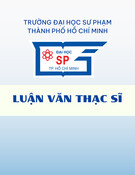

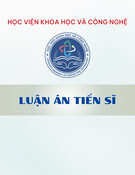
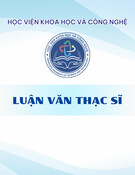
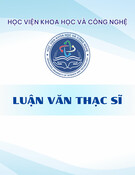
![Luận văn Thạc sĩ: Tổng hợp và đánh giá hoạt tính chống ung thư của hợp chất lai chứa tetrahydro-β-carboline và imidazo[1,5-a]pyridine](https://cdn.tailieu.vn/images/document/thumbnail/2025/20250807/kimphuong1001/135x160/50321754536913.jpg)
